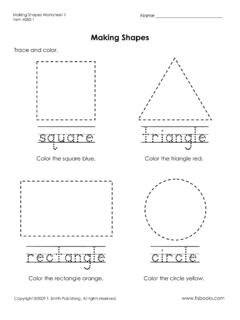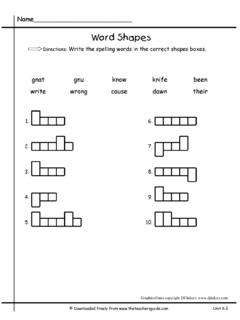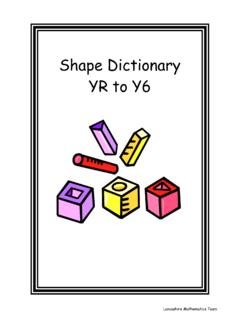Transcription of Georgia Standards of Excellence Curriculum …
1 These materials are for nonprofit educational purposes only. Any other use may constitute copyright infringement. Georgia Standards of Excellence Curriculum Frameworks GSE First Grade Unit 6: Understanding Shapes and Fractions Mathematics Georgia Department of Education Georgia Standards of Excellence Framework GSE Understanding Shapes and Fractions Unit 6 Mathematics GSE First Grade Unit 6: Understanding Shapes and Fractions Richard Woods, State School Superintendent July 2018 Page 2 of 94 All Rights Reserved Unit 6: Understanding Shapes and Fractions TABLE OF CONTENTS Overview.
2 3 Standards for Mathematical Practice ..3 Standards for Mathematical Content ..3 Big Ideas ..4 Essential Questions ..4 Concepts and Skills to Maintain ..4 Strategies for Teaching and Learning ..5 Selected Terms and Symbols ..8 FAL ..9 Number Writing in Page Citations ..10 Tasks ..11 Intervention Table ..14 1. Circus Trip ..15 2. What Are Attributes? ..18 3. Which One Doesn t Belong? ..25 4. Build A Shape ..30 5. Partitioning All Around My Shapes ..34 6. Pattern Block Pictures ..38 7. Day at the Museum ..44 8. Shape Detective ..47 9. Fractions Are Easy As Pie ..51 10.
3 I Want Half! ..57 11. Half and Not 12. Hands On 13. Sweets for the Sweet ..70 14. Let s Eat! ..75 15. Geoboard Fractions ..84 16. Lily s Birthday ..88 17. Connecting Shapes and Fractions ..92 IF YOU HAVE NOT READ THE FIRST GRADE Curriculum OVERVIEW IN ITS ENTIRETY PRIOR TO USE OF THIS UNIT, PLEASE STOP AND CLICK HERE: Return to the use of this unit once you ve completed reading the Curriculum Overview. Thank you! Georgia Department of Education Georgia Standards of Excellence Framework GSE Understanding Shapes and Fractions Unit 6 Mathematics GSE First Grade Unit 6: Understanding Shapes and Fractions Richard Woods, State School Superintendent July 2018 Page 3 of 94 All Rights Reserved OVERVIEW In this unit, students will.
4 Study and compose two- and three-dimensional figures identify basic figures within two- and three-dimensional figures compare, contrast, and/or classify geometric shapes using position, shape, size, number of sides, and number of angles solve simple problems, including those involving spatial relationships investigate and predict the results of putting together and taking apart two- and three-dimensional shapes create mental images of geometric shapes using spatial memory and spatial visualization relate, identify, partition, and label fractions (halves, fourths) as equal parts of whole objects apply terms such as half of, quarter of, to describe equal shares.
5 Although the units in this instructional framework emphasize key Standards and big ideas at specific times of the year, routine topics such as counting, time, money, positional words, patterns, and tallying should be addressed on an ongoing basis through the use of calendar centers and games. Standards FOR MATHEMATICAL PRACTICE The Standards for Mathematical Practice describe varieties of expertise that mathematics educators at all levels should seek to develop in their students. These practices rest on important processes and proficiencies with longstanding importance in mathematics education.
6 Students are expected to: 1. Make sense of problems and persevere in solving them. 2. Reason abstractly and quantitatively. 3. Construct viable arguments and critique the reasoning of others. 4. Model with mathematics. 5. Use appropriate tools strategically. 6. Attend to precision. 7. Look for and make use of structure. 8. Look for and express regularity in repeated reasoning. **Mathematical Practices 1 and 6 should be evident in EVERY lesson** Standards FOR MATHEMATICAL CONTENT Reason with shapes and their attributes. Distinguish between defining attributes ( , triangles are closed and three-sided) versus non-defining attributes ( , color, orientation, overall size); build and draw shapes to possess defining attributes.
7 Georgia Department of Education Georgia Standards of Excellence Framework GSE Understanding Shapes and Fractions Unit 6 Mathematics GSE First Grade Unit 6: Understanding Shapes and Fractions Richard Woods, State School Superintendent July 2018 Page 4 of 94 All Rights Reserved Compose two-dimensional shapes (rectangles, squares, trapezoids, triangles, half-circles, and quarter-circles) or three-dimensional shapes (cubes, right rectangular prisms, right circular cones, and right circular cylinders) to create a composite shape, and compose new shapes from the composite This is important for the future development of spatial relations which later connects to developing understanding of area, volume, and fractions.
8 Partition circles and rectangles into two and four equal shares, describe the shares using the words halves, fourths, and quarters, and use the phrases half of, fourth of, and quarter of. Describe the whole as two of, or four of the shares. Understand for these examples that decomposing into more equal shares creates smaller shares. BIG IDEAS The properties of shapes make them alike or different. Some shapes have sides, angles, and faces which can be counted. Patterns can be created, extended, and transferred through the use of geometric shapes.
9 Location of shapes can be described using positional words. Equal means being of the same size, quantity, or value. ESSENTIAL QUESTIONS What are attributes? How can shapes be sorted? How are shapes used in our world? What makes shapes different from each other? How can I create a shape? How do shapes fit together and come apart? Where can we find shapes in the real world? What is a 2-dimensional shape? What is a 3-dimensional shape? How are shapes alike and different? How can we divide shapes into equal parts? How do we know when parts are equal?
10 How can we divide shapes into equal parts? CONCEPTS/SKILLS TO MAINTAIN Sorting shapes into groups Positional terms Find and name shapes in the environment Compose and decompose shapes Identify two and three dimensional geometric shapes 1 Students do not need to learn formal names such as right rectangular prism. Georgia Department of Education Georgia Standards of Excellence Framework GSE Understanding Shapes and Fractions Unit 6 Mathematics GSE First Grade Unit 6: Understanding Shapes and Fractions Richard Woods, State School Superintendent July 2018 Page 5 of 94 All Rights Reserved STRATEGIES FOR TEACHING AND LEARNING Students should be actively engaged by developing their own understanding.

















